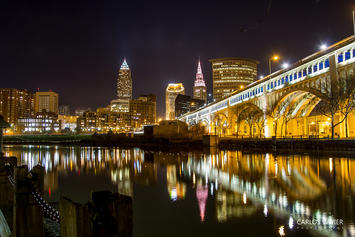
Part 1: Innovation and “the Next Silicon Valley”
It’s mayoral season in Cleveland and a number of viable candidates are lining up. With political candidacies inevitably comes political agendas. We will hear a lot about what a given candidate thinks has or hasn’t worked in Cleveland. We will also hear prognosticating about the future of Cleveland. Are we trending in the right direction? Regressing? Or stilled in a lukewarm bath of status quo?
While these retrospectives and prognoses are welcomed, there’s a catch. Most politicians aren’t very good at offering a compelling vision of the places they represent. They also struggle with explaining how and why a city evolved the way it did, if only because they are pigeonholed into the local and thus unable to nest their locale in the context of what’s global. This is a problem. Because what’s global becomes local. “[G]lobalization has been shown to increase the standard of living in developing countries,” explains a writer for National Geographic,” “but…globalization can have a negative effect on local or emerging economies and individual workers.” Cleveland’s story is not just Cleveland’s story, then,it’s the story of a region in a country in a world that’s constantly changing. The key is to find patterns within this change. If only to know what’s in your power as a person, or a collection of people — a city — so the change is less random and disruptive and thus planned for. Otherwise city building is just one big shit show of pure emotion expressed by the powerful that’s dispensed as policy.
This is not a knock against politicians, local or otherwise. It’s only an acknowledgement of the constraints of politics, or the political milieu from which the politician is machined to operate. Politician’s, after all, work in the time constraints of “short-termism”, in which the tactical for today continually usurps the strategic for tomorrow. The philosopher Roman Krznaric notes this default setting toward short-termism flows from the electoral cycle, which he calls “an inherent design flaw of democratic systems that produces short political time horizons”. This, in turn, leads to myopic decision-making that keeps kicking proverbial cans down the road. The figure below is illustrative. In 1979, the State of Ohio allocated 17.7% of its budget toward investment in higher education. That’s down to 10.6%. Meanwhile, spending on corrections increased from 2.2% to 7.1% over the same time period. Such is the case of mortgaging the future to band-aid the present while neglecting the past.
Combatting short-termism entails institutionalizing a long-term vision amongst policymakers. When I say “vision”, what does that mean exactly? It means trying to figure out what’s going on in this complex, crazy world and then thumbtacking Cleveland’s place in it, if only so the region has a compass to help it move in accordance with the winds of change. Absent that, cities get left behind. “Globalization didn’t kill Detroit,” explains Jim Russell in the Pacific Standard, “globalization avoided Detroit.”
Below, the contours of a vision for Cleveland are sketched out. This is part 1 of a 4-part series, comprising part of a writing project called Life After Rust. The series is an outgrowth of past work that focused on the trajectory of Rust Belt cities, or the tendencies for some to live, die, and revitalize, versus the tendencies for more to live, die, and stay stuck. The culmination of that work can be found in a recent white paper called “The Future of Growth”. The overarching goal? To simply the complex of how and why the global economy is changing, and then show how those “upstream” changes get played out “downstream” at different geographic scales — be it the state, the city, the neighborhood, the household, or the individual. As for motive, there is none outside sharing what I learned while I have the time to do so.
Read the rest of this piece at RicheyPiiparinen.Medium.com.
Richey Piiparinen studies the life of Rust Belt cities at Cleveland State. Co-Founder, Rust Belt Analytica. Director, “Life After Rust”. Husband, father, Clevelander.
Photo credit: Carlos Javier via Flickr under CC 2.0 License.












